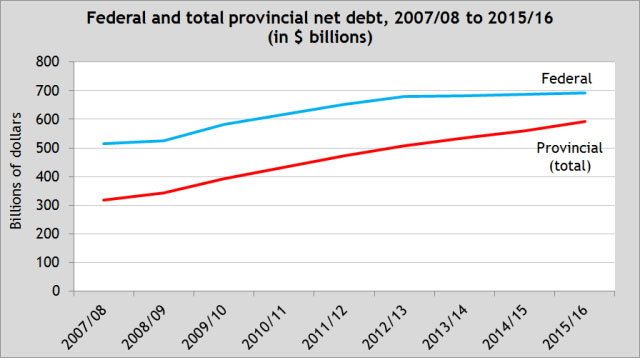Provinces drive most of Canada’s government debt growth
A recent Fraser Institute study found that Canadian governments have racked up a considerable amount of new debt since 2007/08.
Eight years ago, combined federal and provincial government net debt (a measure of debt that adjusts for financial assets) stood at $834 billion. By 2015/16, it’s expected to reach $1.3 trillion. While both federal and provincial net debt is on the rise, the pace of debt accumulation at the two levels of government has been markedly different in recent years.
So the question is: what level of government is responsible for most of the new debt?
The chart below displays federal and total provincial net debt from 2007/08 to 2015/16. Although federal debt is 34 per cent higher today than in 2007/08 (growing from $516 billion to $692 billion), the level began to stabilize in 2012/13. Total provincial debt, on the other hand, has steadily increased over the entire period, growing by 87 per cent (from $318 billion to $592 billion). In other words, total provincial government debt is growing at a much faster pace than federal debt.

In fact, of the $451 billion in new combined federal-provincial net debt since 2007/08, $275 billion (or 61 per cent) is from the provinces. As a result, provincial government debt now represents a larger share of combined federal-provincial debt (46 per cent of the total in 2015/16, up from 38 per cent in 2007/08).
Interestingly, more than half of new provincial government debt since 2007/08 comes from a single province: Ontario, where net debt nearly doubled from $157 billion to $298 billion. Only three of the 10 provinces saw government debt grow at a slower rate than the federal government (Nova Scotia, Saskatchewan, and Newfoundland and Labrador).
That is not to say the federal government’s recent record is a model for the provinces to emulate. However, provincial governments generally, and Ontario in particular, have allowed debt to accumulate at a more rapid rate.
The rapid pace of debt accumulation at the provincial level raises concerns about the federal government’s deteriorating fiscal position. The federal government’s budget deficits in the years ahead may greatly exceed the $10 billion ceiling on which they campaigned. In fact, the government’s proposed “fiscal anchor” would allow annual deficits to climb as high as $25 billion. If the federal government accelerates its pace of debt accumulation, and the provinces continue at their current pace, the result could be a substantial increase in the overall level of combined debt left for future generations of Canadian taxpayers to service and repay.
As we approach budget season and governments begin to unveil their tax and spending plans for the future, all governments in Canada should take steps to rein in debt given the adverse short- and long-term economic consequences.
Authors:
Subscribe to the Fraser Institute
Get the latest news from the Fraser Institute on the latest research studies, news and events.

